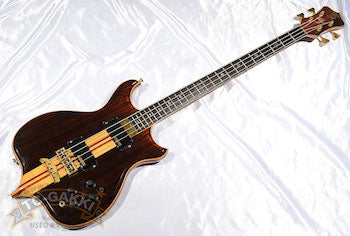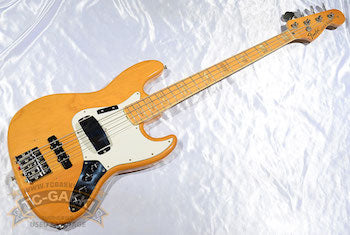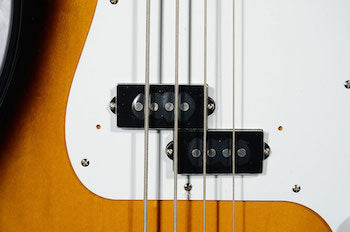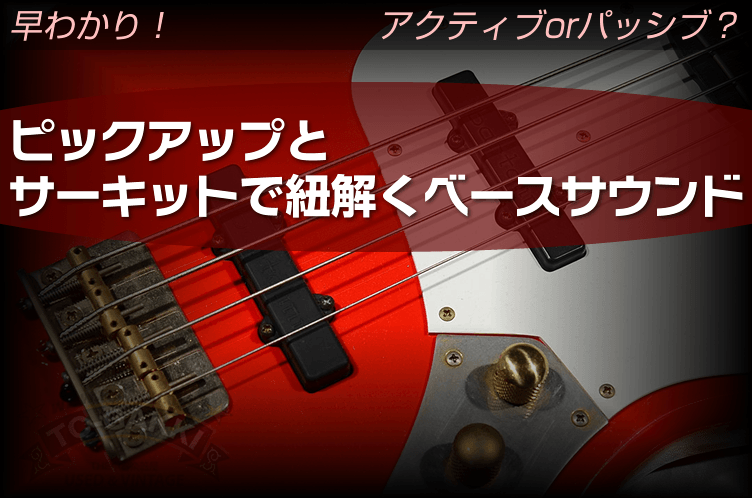
The sound of an electric bass depends on the type of wood used for the body and neck.
and weight of the body and neck, as well as the shape and construction of the bass, but the influence of the pickups and other circuitry is also a factor.
Pickups and other circuitry also play an important role in the sound of an electric bass. Here, we will focus on the "electric" part of the electric bass.
I would like to compare the differences in sound.
Traditional Style
It all started here, the origin of electric bass.

Photo shows one made in 1968.
After creating the world's first solid-body electric guitar, Leo Fender now embarked on the development of the bass guitar. At the time, upright basses were the most common type of bass, and their large size was a problem for musicians who traveled across the United States on tour. The upright bass was also difficult for guitarists to play on a temporary basis due to its special characteristics, so Leo set his sights on creating an electric bass that could be played in the same way as an electric guitar, but in a smaller size. The Fender Precision bass was released in 1951. Its surprisingly compact size compared to upright basses and the frets on the fingerboard made it easy for anyone to play, and it became the starting point for later electric basses.

The pickup is a simple single coil.
This is the world's first electric bass, so it is a very simple style. However, because there are very few elements that depend on the electric circuit, the nuances of the player's touch are reflected honestly, and there are many users who still love this style.
The 1957 style, which has further evolved, has become a worldwide standard.

The photo was taken around 1966.
The revolutionary appearance of the Precision Bass led to many bass players picking up the instrument, but there was one problem: the hum of the single coil. However, there was one problem: the hum of the single coil. To solve this problem, Leo introduced the new Precision Bass in 1957, using two coils, one for the 1st and 2nd strings and the other for the 3rd and 4th strings, to cancel the hum noise. The two coils wired in series inevitably have more coil windings, resulting in a more powerful sound. The bass string side is mounted closer to the neck, and the treble string side is mounted closer to the bridge, resulting in a fat bass and crisp treble.


Another World Standard
The JJ style was introduced in 1960.

Photo shows Jazz Bass circa 1964.
After the great success of the 1957 Precision Bass, Leo continued to work on the development of a new style of bass. In 1960, Leo introduced the Jazz Bass, which featured two hum-canceled pickups mounted on the neck and bridge sides, each with its own volume control, allowing for a more subtle and wider range of sound production than the Precision Bass. The Jazz Bass pickups are called "J-type" pickups, and are still used in many electric basses today.


Other Traditional Pickups

The EB-3 is a representative bass by Gibson, a leading company in the electric guitar world along with Fender, and is equipped with Gibson's signature humbucking pickups. The EB-3 is equipped with Gibson's signature humbucking pickups, and the huge humbucking pickups mounted on the neck side can produce a ground-crawling, undulating roar. Combined with the crisp mini humbucker on the bridge side, the sound can be created in any direction.


Rickenbacker's 4001 is equipped with a unique pickup called a "horseshoe" or "toaster" pickup, so named because of its unique shape. The bridge pickup resembles a toaster in a bread machine. The front pickup, which resembles a toaster in a bread machine, is also unique, and is loved by many players, including Paul McCartney of the Beatles, for its one-of-a-kind Ricken sound.

Introduction of Active Circuit
In the 1970s, the introduction of synthesizers led to a heavier ensemble band sound and a change in the sound of the electric bass. The band's sound became more ensemble-heavy, and the electric bass required more precise control of its frequency range in order to avoid being overshadowed onstage. In order to enhance the presence of the bass without interfering with other instruments, circuits with built-in equalizers and frequency-specific volume control became the norm. With the rise of a new style of music scene called crossover/fusion, the role of the bass in a band and its playing style evolved, and the sound creation became more diverse.
A new era was dawning: the Alembic circuit.

Photo shows the Mark King model from 1987
Alembic is said to be the first electric bass in the world to incorporate an original active circuit with a semi-parametric structure that allows control over the mid-range frequencies, allowing you to boost or cut just the bandwidth you need. Even in a situation where all the instruments on stage were filling up the middle range, it was possible to control the sound to make it stand out by exploiting the gaps. Listening to it alone, it also has a distinctive sound that sounds a bit nasal.



It also runs on the now-familiar 9V battery.
This was revolutionary at the time.
A new world standard. The Active JJ style.
The chopper/slap technique, in which the bass guitar plays the role of a rhythm instrument in a drumless ensemble, is used to create a driving rhythm by comparing the sound of the bass string hitting the bass drum to the sound of a snare drum, and the sound of the treble string bursting into life to the snare drum. The appearance of bassists such as Larry Graham and Marcus Miller, who specialize in this evolved style, has given the bass guitar a new role. The bass guitarist's role was no longer limited to that of a "behind-the-scenes" player, as the demand for a shimmering high note to accentuate the rhythms of the instrument grew. Roger Sadowsky was one of the first to respond to this need. The clear, crisp Fender Jazz Bass with an active circuit is now the new standard for custom basses. This style has become the new standard and is still used in many scenes today.

Modified by Roger Sadowsky
1974 Fender Jazz Bass

Active circuit is built in.
Treble/Bass control is added.

This is Sadowsky's JB style.
One of the perfection of modern style bass.


Toward a new style. One answer of "Made in Japan".
Naturally, Japanese manufacturers were not indifferent to this movement toward a new era with built-in active circuits, and many famous models were produced, such as FERNANDES' FAB, which beautifully imitated the Alembic circuit, and Greco's GOB, which was influenced by B.C. Rich's circuit. The most famous of these models are the active models that are the pride of Japan. One of the most representative of Japan's world-class active models is the Ibanez Musician Series MC-924. The original active circuit produced a massive organ-like sound, and was used by musicians not only in Japan but also around the world, including Sting and Thin Lizzy's Phil Lynot.

This model represents Japan in the 80's.
Ibanez MC-924
Harder & Heavier
In the 1980s, the heavy metal movement ignited the era. Guitarists modified Marshall's three-stacks to distort even more, and the demand for a harder and louder sound grew. To counter these pressures, bass players demanded a tighter, wilder sound as well. A solid low end that does not get buried in heavy riffs, does not lose out to the intense 2-bass, and accelerates the sound even further. Various models were born to meet these needs, and one of the models that epitomizes this scene is Spactor's NS-2. The NS-2 is equipped with EMG pickups and an original circuit in an ergonomically designed through-neck with a three-dimensional line. This model is the flagship of basses that specialize in heavy sounds.




Genealogy of Heavy Sound
After the heavy metal movement took over the world, the heavy sound evolved in a more diverse way. It became heavier and louder, as symbolized by the "mixture" genre. However, it is not all about roaring, but sometimes funky, sometimes groovy, solid and tight tone, with a shimmering sense of escape, and Warwick is a representative of this era, an evolved version of Spector. Warwick's Spector is an evolved version of Warwick, using dense and heavy woods such as bubinga and wenge, and equipped with a more advanced active circuit. The Warwick Spector is the embodiment of modern heaviness.

The photo shows a 1997 Warwick Thumb Bass.

The boldly slant-mounted J-type pickups produce even sharper bass.

18V circuit for clearer and wider range sound.
The origin of continuous evolution. Leo Fender's insatiable quest.
The changes in the music scene and the bass circuit. How did Leo Fender, the creator of the electric bass, view these changes in the music scene and the bass circuit? Leo Fender, who had already sold Fender to CBS in 1972, started a new company, Musicman, and began designing new instruments. In 1976, Leo introduced the Stingray, a representative active bass. A single large humbucking pickup is mounted on the bridge side and controlled by an originally developed active circuit. Its powerful yet flexible sound has been used not only by the music scene of the time, but also by musicians representing each era, such as Flea of the Red Hot Chili Peppers, as a standard model that transcends time.

The photo shows a Musicman Stingray from 1982.

The large humbucking PU on the pole piece is a distinctive feature.

Volume, treble, and bass controls. Middle was later added to make it a 3-band.

Simple but flexible active circuit for sound creation.
The end of the line for Leo Fender; G&L.
Leo Fender's last brand, G&L, was his last stop. Here, Leo developed a series of models that can be said to be the culmination of his career. It can be seen that G&L was a brand for doing what Leo really wanted to do, as he later said, "I have nothing left to do. The L-2000 is unquestionably the most representative model of the G&L lineup. Equipped with two humbucking pickups, a selector switch, coil split switch, and a switch that switches between two modes of active circuit and passive mode, this model can reproduce the bass sound of any era Leo was involved with.
|
|
|
|
G&L L-2000 in the 1990s |
Original MFD humbucking pickup designed by Leo Fender. |
|
|
|
|
|
|
|
With the mini-switch, you can reproduce Jazz Bass, Precision Bass, and Stingray-like sounds. Of course, the L-2000's powerful 2-hum sound is also attractive. |
The circuit can be selected between a fat sounding mode, a high treble mode, and a passive mode. The L-2000 can be controlled from a modern JB-like sound to a vintage tone. |
TCGAKKIYou can try it all out at
From the classic to the super unique.
Pickup layouts from classic to unique.

◎J-J
Traditional jazz bass style
Good balance of each bandwidth and clear, crisp sound with clear contours.
Artist:Jaco Pastorius, Marcus
Miller, Geddy Lee, etc.
Main Brand: Fender, etc.

◎P
The well-known royal road precision style
Low noise and fat warm sound due to hum cancellation effect.
Artists used: James Lee Jamerson, Sid
Vicious, Steve Harris, etc.
Main Brand: Fender, etc.

◎P-J
A style that combines the best of the classic Precision and Jazz basses.
There is also a style called "Reverse P," in which the P is mounted in the opposite direction. The moderate fatness of the P is mixed with the clear contours of the J for a well-balanced, easy-to-handle sound.
Artist:Duff Mckagan, Stuart Zender, Nathan East, etc.
Major brands used: Fender, Warwick, Spector, etc.

◎H
Wide range, low noise, and low mid are the characteristics of this guitar, which has a fat, clear, aggressive, and aggressive sound.
Artist:Flea, Louis Johnson, Cliff
Williams, etc.
Main Brands Used: MUSICMAN, G&L, Gibson, etc.

◎P-H(H-P)
Mixes the low-noise, fat, warm sound of Precision with a humbucker mounted on the bridge side.
It is characterized by a fat and fat sound.
Artist:Akihiro Namba, Billy Sheehan, etc.
Major brands used: ESP, YAMAHA, Sandberg, etc.

◎J-H
Similar to the P-H, but the combination of the J's clear, crisp sound and the humbucker's fat low mid is well-balanced.
Versatile sound makeup is possible in combination with series/parallel/tap switching of the humbucker.
Artist used: tetsuya,
Main brand used: LAKLAND

◎P-P
Low noise and fat, with good low-frequency output, giving a solid impression that firmly supports the bottom end in ensembles, etc.
Artist:Hitotoki
Main Brands Used: Schecter, ESP, B.C.Rich, Fender Japan

◎J-J-J
Jazz bass with an additional J mounted as a 3-single. This is a rare combination, and the J is added to the original hum canceled bass, so it is a little noisy. The sound is well-balanced and clear, and is famous for Fender's Bass VI, etc.
Artist:tetsuya, Hitoki
Main Brand: ESP, DINGWALL

◎P-P-J
Low noise and fat, with good low-frequency output, giving a sturdy impression that supports the ensemble, etc.
The J on the bridge side adds just the right amount of edge and balance.
Artist:Masayoshi Yamashita
Main Brand:ESP

◎H-H
Versatile type that allows a variety of combinations from J-J to J-H and H-H by combining series/parallel/tap of each humbucker.
Low noise and thick rock sound to delicate jazz bass-like sound!
Artist:tetsuya, IKUO
Main Brand: LAKLAND, Warwick, TUNE

◎J-P-J
This layout can be described as a fusion of a jazz bass and a precision bass. The J-P-J is an extremely well-balanced and versatile type that can be used independently of each other depending on the wiring. It mixes the well-balanced, clear, and crisp sound of the Jazz Bass with the low-noise, fat, and warm sound of the Precision Bass's hum-canceling effect.
Artist used: Stuart Hamm
Main Brand:Fender

◎J-H-J
The impression is similar to that of the J-P-J, but the powerful sound of the humbucker and the clear contours of the jazz bass combine to create a more balanced combination than meets the eye.
Artist:Kenji Hino
Main Brand: Atelier Z, Sandberg, etc.

◎Independent pickups for each string
Each string is independent, allowing balance adjustment for each string.
The sound is well-balanced from low to high frequencies, giving a calm impression. Our repairman, Soichiro Tanaka, is also a fan of this pickup!
Major brands used: Atlansia, etc.
☆Main pickup makers☆
There are replacement pickups from various manufacturers! If you are not satisfied with the sound of your bass pickups and want to replace them, here are some of the major makers and their sound images!
Fender
Fender specializes in traditional jazz bass and precision bass pickups with a traditional vintage style sound.
Seymour Duncan
Seymour Duncan is a manufacturer that produces a wide range of pickups from modern to vintage style.
Dimarzio
Dimarzio offers a wide range of models from aggressive sounds like hard rock and metal to modern vintage styles. There are many unique and distinctive pickups in general, and there are a wide variety of models that once you get into them, you will not be able to get out of them.
◎Bartolini
Bartolini pickups are characterized by their low noise and sweet, elegant sound character. This pickup is often installed in so-called high-end basses, and its moderate compression is recommended for finger picking and slapping.
EMG
Clear, low-noise, wide-range active pickup. It produces a clear and contoured sound not only when played with a pick, but also when finger-slapped or finger-slapped.
Lindy Fralin
A maker that specializes in traditional vintage style sound.
Nordstrand
Nordstrand pickups are carefully hand-wound to reproduce the vintage sound of Fender pickups, and have a vintage-like sound.
~Last but not least, we have
There are many different combinations of bass pickups. It is interesting to try various combinations to find your ideal sound. We have a lot of basses with various pickup layouts in stock at our store!♪If you are interested in any of them, please come to our store to try them out!♪」





